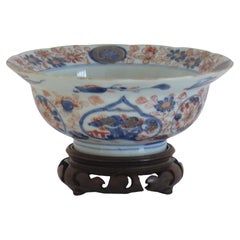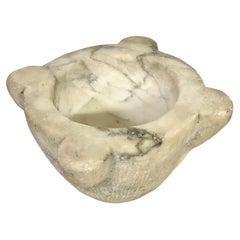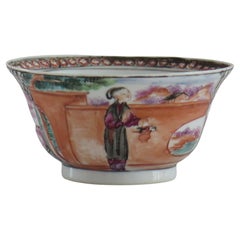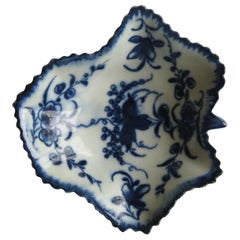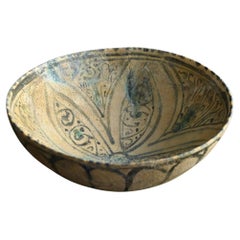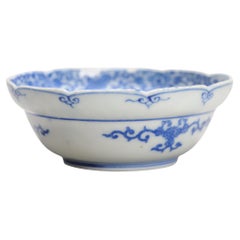18th Century and Earlier Decorative Bowls
to
78
380
380
1,171
7,679
2,460
981
3,973
1,605
160
62
239
296
163
710
1,000
611
254
100
22
21
20
9
7
6
6
6
2
215
114
74
64
38
183
177
188
155
125
75
40
Height
to
Width
to
380
380
380
3
2
2
2
2
Period: 18th Century and Earlier
Chinese Kangxi Export Porcelain Imari Bowl with Wood Stand, Qing Circa 1700
Located in Lincoln, Lincolnshire
This is a beautiful Chinese Export porcelain footed Bowl with fine Imari hand painted decoration, dating to the Qing, Kangxi period, circa 1700. The bowl comes with a Chinese hardwoo...
Category
Chinese Qing Antique 18th Century and Earlier Decorative Bowls
Materials
Porcelain
18th Century Large White Marble Mortar
Located in LA CIOTAT, FR
An 18th century mortar made from hand-carved beautifully veined Carrara marble. Fashioned in the traditional style, with four shaped corners and a deep bowl, this would once have bee...
Category
French Antique 18th Century and Earlier Decorative Bowls
Materials
Marble
18thC Chinese Porcelain Bowl Hand Painted Famille Rose, Qing Qianlong circa 1760
Located in Lincoln, Lincolnshire
This is a finely hand painted Chinese porcelain bowl from the 18th century, Qing dynasty, Qianlong period, 1736-1795.
The bowl is beautifully decorated with two panels of figure sce...
Category
Chinese Chinese Export Antique 18th Century and Earlier Decorative Bowls
Materials
Porcelain
First Period Worcester Pickle Leaf Dish in Blue Floral Pattern, Ca 1770
Located in Lincoln, Lincolnshire
This is a very good early, First period (Dr. Wall), Worcester porcelain leaf shaped Pickle Dish in a deep cobalt blue floral pattern with a Crescent mark to the base. dating to 1770 ...
Category
British George III Antique 18th Century and Earlier Decorative Bowls
Materials
Porcelain
Very old Iranian blue-glazed pottery bowl/12th century/Persia pottery
Located in Sammu-shi, Chiba
This pottery was made around the 12th century, likely in the region around Iran.
In Japan, this type of pottery is commonly known as "Persian pottery."
In addition to polychrome-pain...
Category
Persian Other Antique 18th Century and Earlier Decorative Bowls
Materials
Pottery
Blue and White Arita Japanese Porcelain Printed Period Bowl, 18th Century
Located in Amsterdam, Noord Holland
Sharing this lovely 19th century bowl. Printed.
Additional information:
Material: Porcelain & Pottery
Japanese Style: Imari
Decoration Type / Colour: Imari
Region of Origin: Japan
P...
Category
Japanese Edo Antique 18th Century and Earlier Decorative Bowls
Materials
Porcelain
$88 Sale Price
20% Off
French 18th-19th Century Black Marble Mortar
Located in Buisson, FR
Beautiful and rare black marble (Belgium blue stone) mortar, France, circa 1750-1850. Great eyecatcher.
Weathered but good condition.
Category
French French Provincial Antique 18th Century and Earlier Decorative Bowls
Materials
Belgian Black Marble
$444 Sale Price
58% Off
Exquisite 13th Century Rock Crystal and Gold Bowl in Superb Condition
Located in London, GB
Rock crystal vessels were highly demanded and valuable in Medieval times. Inventories from European royal houses and the highest aristocratic families detail the important and sophisticated collections of ewers and bowls. Rock crystal has also been used extensively in religious art. Fine European reliquaries were also made of Rock Crystal including gems, enamel and other precious materials. The work of rock crystal is very ancient. The materials has been worked and valued for its solidity and its purity: it has been believed to be water ice permanently frozen.
Our superb example is a gold-mounted rock crystal bowl with enamel.
The items origin is not clear and various features and characteristics may lead us to think of different origins and periods of creation.
A single piece of stone mounted with gold could be a Milanese work. Although the cut could be French as similar pieces belonged to the French royalty (especially the art lover Duc de Berry, (1340-1416)). French and Italian crystal cutters have been active at the same time and it is often difficult to differentiate their works.
Islamic art also influenced European artists. The famous Fatimid treasury provided examples of their sophistication and quality. The seven ewers carved for the Fatimid Imans (known as "The Magnificent Seven") display impressive quality of both rock crystal and enamelled mounts.
Even though not identical to works by French silversmith Jean-Valentin Morel who was appointed goldsmith to Queen Victoria in 1852 or Reinhold Vasters (1927-1909) another renown German goldsmith who embellished older rock crystal items, there are similarities between these works. Both reduce their use of colour to black and white on pure gold mounts. Moreover the black enamel design is quite similar. Also, no gems are included and no human figure is represented.
Sotherby's described our bowl as a "German Rock crystal bowl with later gold mounts, 15th century." Other items from the period from Germany or Austria are usually silver mounted and the decorations are more colourful and include gems or human figures but they have in common enamel motifs.
In our case, the gold foot, handles and rim could date from the 1900s. An expert has established the foot, handles and rim are pure gold. The goldsmith responsible for the improvement of the bowl is possibly the most famous Reinhold Vasters whose work has been displayed in the greatest museums such as the V&A in London and the Metropolitan Museum of Art in New York.
The Rock Crystal bowl we have is gold mounted. The gold shows in enamelled details that are black and white. The gold handles are also enamelled with black acanthus-like leaves.
The enamelling method could be "champleve" or "painting metal". The metal that is usually preferred is copper but these techniques are also applied to gold.
The bowl itself could be from the 14th century. It's cut reminds of an estimated 14th century rock crystal ball bearing the Buoncompagni family arms...
Category
Italian Antique 18th Century and Earlier Decorative Bowls
Materials
Rock Crystal
18th Ctr. English Mortar and Pestle in Pachyloba Hardwood
Located in Kastrup, DK
An elegant antique mortar and pestle, finely crafted from tropical hardwood, most likely pachyloba, with a rich grain and warm patina.
It remains in excellent original condition.
Mea...
Category
English Georgian Antique 18th Century and Earlier Decorative Bowls
Materials
Hardwood
Japanese antique pottery bowl/Tokoname ware/12th-13th century/excavated pottery
Located in Sammu-shi, Chiba
This is a pottery called Tokoname ware.
Tokoname is a kiln located in Aichi Prefecture, Japan (Tokoname Kiln is marked with a red circle on the map).
It is said to have originated ar...
Category
Japanese Other Antique 18th Century and Earlier Decorative Bowls
Materials
Pottery
Small French Bronze Mortar and Pestle with Fleur De Lys and Crown, Circa 1700
Located in Dallas, TX
This small bronze mortar and pestle are from France, circa 1700. The circular opening has several layers of molding, with the bottom three interrupted by a pair of open crowns on opp...
Category
French Louis XIV Antique 18th Century and Earlier Decorative Bowls
Materials
Bronze
Spanish 18th Century Marble Mortar
Located in Round Top, TX
A very charming 18th century mortar from the Catalan region in Spain. Beautifully carved from stone. A wonderful accessory piece for any kitchen, bathroom, or table top.
Category
Spanish Antique 18th Century and Earlier Decorative Bowls
Materials
Marble
Antique Medieval Tuscan Mortar in Nembro Marble, Italy
Located in Roma, IT
Incredilbe apothecary Mortar in Nembro Marble, made from a single block of marble and dated back to the early 600 from Tuscany. It was used in the in apothecaries to grind herbs and spices into powder for food or medicine.
Very unique and rare piece in great conditions considering the the period to which it dates.
This highly sculptural and unique piece would be suitable today as a magnificent decoration on a table or mantle, or to grace the counter of an open kitchen...
Category
Italian Medieval Antique 18th Century and Earlier Decorative Bowls
Materials
Marble
Large 18th C Blue and White Spanish Lebrillo Bowl
Located in Hastings, GB
A large Lebrillo bowl, made in Granada, Spain in the late 18th century. Hand decorated using blue paints, most likely formed using a variety of ground mi...
Category
Spanish Spanish Colonial Antique 18th Century and Earlier Decorative Bowls
Materials
Ceramic
18th Century Spanish or North African Faience Deep Bowl
Located in Chapel Hill, NC
A stunning Spanish or North African faience deep bowl. 18th century. Well cared for with various old rim repairs typical of the form. Red ware base. 15 1/4" diameter, 4" height.
We ...
Category
Antique 18th Century and Earlier Decorative Bowls
Materials
Ceramic
$695 Sale Price
42% Off
Large Antique Chinese Export Porcelain Bowl Famille Rose Hand Painted C-1770
Located in Katonah, NY
This exquisite 18th-century Chinese export porcelain bowl was hand-painted during the Qianlong era, circa 1770, using colored enamels in the Famille Rose palette.
Pink peonies in ful...
Category
Chinese Chinese Export Antique 18th Century and Earlier Decorative Bowls
Materials
Porcelain
16th Century Spanish Terracotta Vase
Located in Miami, FL
16th Century Spanish Terracotta Vase
Hand made marks around the vase.
Category
Spanish Baroque Antique 18th Century and Earlier Decorative Bowls
Materials
Terracotta
Antique Persian Etched Tinned Copper Footed Decorative Bowl, Circa 18th C
Located in Germantown, MD
An antique Islamic or Indo-Persian etched footed bowl, made of tinned copper, dating possibly from the 17th to 18th century. Key features include:
Constructed from tinned copper
...
Category
Persian Moorish Antique 18th Century and Earlier Decorative Bowls
Materials
Metal, Copper, Tin
French 18th-19th Century Black Marble Mortar
Located in Buisson, FR
Beautiful and rare black marble (Belgium blue stone) mortar, France, circa 1750-1850. Great eyecatcher.
Weathered but good condition.
Category
French French Provincial Antique 18th Century and Earlier Decorative Bowls
Materials
Belgian Black Marble
$444 Sale Price
58% Off
Chinese Export Porcelain Large Famille Rose Punch Bowl
Located in Downingtown, PA
Chinese Export Porcelain Large Famille Rose Punch Bowl,
Circa 1765-75
A large Chinese export porcelain punch bowl, distinguished by its vibrant famille rose enamel decoration. The e...
Category
Chinese Chinese Export Antique 18th Century and Earlier Decorative Bowls
Materials
Porcelain
Chinese Export Porcelain Punch Bowl Sailor Farwell & Return with Royal Navy Ship
Located in Downingtown, PA
Chinese Export Porcelain European-subject Punch Bowl,
Sailor's Farewell and Return Bowl with Royal Navy Ship,
Circa 1765-75
The Chinese Export porcelain bowl has two images of a sailor and his wife, one known as the sailor's farewell and the other the sailor's return.
The farewell depicts the sailor leaving his wife who hugs him as he is about to depart as he points to the Royal Navy Ship with the Blue Ensign just offshore. The sailor's return depicts the sailor depositing watches and coins into his wife's upraised apron. Between the images are large painted flowering branches and the interior has similar painting.
Dimensions: 10 1/4 inches x 4 1/2 inches high (26.04 cm diameter x 11,43 cm high)
Provenance: With Elinor Gordon;
Ruth Nutt Collection
Sailor's Farewell and Return Bowl with Royal Navy Ship,
Condition is very good with some fading to the en grisaille sails.
Reference: David S...
Category
Chinese Chinese Export Antique 18th Century and Earlier Decorative Bowls
Materials
Porcelain
18th Century Chinese Export Porcelain Punch Bowl
Located in Fort Lauderdale, FL
A mid-18th century Chinese export porcelain punch bowl, hand-painted with "The Judgement of Paris" after Rubens.
European ceramicists borrowed motifs from Chinese porcelains through...
Category
Chinese Chinese Export Antique 18th Century and Earlier Decorative Bowls
Materials
Porcelain
18th Century French Marble Mortar
Located in Chicago, IL
An 18th-century French carved marble mortar, rich with history and softened by centuries of use, its surface worn smooth with a patina that only 250 years of culinary tradition could...
Category
French Rustic Antique 18th Century and Earlier Decorative Bowls
Materials
Marble
Chinese Export Porcelain Bowl Hand Painted Blue and White, 18thC or earlier
Located in Lincoln, Lincolnshire
This is a Chinese Export porcelain bowl, hand painted in a blue and white pattern, which we date to the 18th Century or earlier, back to late Ming dynasty in the early 17th century. ...
Category
Chinese Chinese Export Antique 18th Century and Earlier Decorative Bowls
Materials
Porcelain
French Arte Populaire Padelle - Copper Pan
Located in Round Top, TX
A wonderful 17th century French Arte Populaire Padelle - Copper Pan. A Padelle is a large copper vessel used in large wood burning ovens to make nut oils. Wonderfully crafted in ve...
Category
French Antique 18th Century and Earlier Decorative Bowls
Materials
Copper
Bronze Pharmacy Mortar Italy-17° Century
Located in Brussels, Brussels
Elegant bronze mortar from the 17 century from Italy dated 1630.
Really rare mortar due to his big size.
In very good condition and beautiful patina.
Category
Italian Renaissance Antique 18th Century and Earlier Decorative Bowls
Materials
Bronze
Large 18th Century, Italian or French White Marble Mortar Phenomenal Patina
Located in Atlanta, GA
Likely Italian or French, 18th century.
An impressive and large mortar carved from a single block of white marble. Showing phenomenal antique patina - this piece was heavily used du...
Category
French Renaissance Antique 18th Century and Earlier Decorative Bowls
Materials
Marble
$1,516 Sale Price
20% Off
Heavy 16th Century French Bronze Mortar with Handles, Dated 1587, 109 lbs
Located in Dallas, TX
A large and heavy (it weighs 109 lbs!) example of a traditional French pharmacy bowl, this bronze mortar with handles is from 1587, as seen on the production date beneath the molded ...
Category
French Renaissance Antique 18th Century and Earlier Decorative Bowls
Materials
Metal, Bronze
17th Century Rare Tibetan Silver Mounted Brul Covered Bowl with Coral
Located in Brea, CA
17th century rare Tibetan silver mounted brul covered bowl with coral bottom, the repousse and domed cover inset with Cora and lapis, big 3cm diameter red coral bottom, some tarnish,...
Category
Tibetan Tibetan Antique 18th Century and Earlier Decorative Bowls
Materials
Silver
18th Century Very Large Burl Bowl
Located in High Point, NC
RARE 18th century American burl bowl. This piece is wonderfully hand turned and the wood is GORGEOUS! It looks alive in the light! This bowl is f...
Category
American American Colonial Antique 18th Century and Earlier Decorative Bowls
Materials
Burl
Islamic Glazed Pottery Bowl with Kufic Calligraphy Nishapur Ware Provenance
Located in Atlanta, GA
An earthenware pottery bowl in conical shape supported by a short foot ring covered in white slip and decorated with black slip paint of calligraphy in Kufic script. This type of bowl is identified as Nishapur ware circa 10-11th century (in nowadays Iran). It was made either in Samanid Dynasty (819–999) or the successive Ghaznavid Empire (977–1186) before the Mongol invasion. The white glaze on the vessel's exterior was thinly applied, resulting in areas with streaks of opaque yellowing. The black slip paint was used to decorate the bowl in flowing Kufic script before a transparent top glaze was applied. The writing, consisting of cursive strokes in bell shape, is likely an Arabic Maxim.
Under UV examination, the bowl shows some professionally restoration as described in condition. It comes with a custom-made acrylic stand as shown.
Provenance: From an American collection, thereby descent. Purchased from Yacobs Gallery, London England, July 1998. Two digital copy the original hand-written documents...
Category
Persian Islamic Antique 18th Century and Earlier Decorative Bowls
Materials
Ceramic
Dutch Delft Blue & White Botanical Bowl
By Delft
Located in Downingtown, PA
Dutch Delft Blue & White Botanical Bowl,
Circa 1720
The high-sided Dutch Delft pottery blue and white bowl with a plain flared foot is painted with a band below the rim of six large...
Category
Dutch Rococo Antique 18th Century and Earlier Decorative Bowls
Materials
Delft, Faience, Pottery
Antique Irish Dublin Delftware Blue White Charger Plate Delamain Ireland 18thCt
Located in Dublin, Ireland
An Extremely Rare Hand Decorated Irish Delftware wall hanging Charger or Cabinet Dublin Plate by Henry Delamain, decorated with flowers and foliage in colours of blue. Possibly third...
Category
Irish Georgian Antique 18th Century and Earlier Decorative Bowls
Materials
Ceramic, Porcelain
Antique Irish Tipperary Waterford Glass Cut Crystal Georgian Centerpiece Bowl 18
Located in Dublin, Ireland
An impressive George II hand cut full led Irish Crystal Pedestal “Kettle Drum” Bowl of circular outline and unusually large proportions. Made by the Old Waterford Glass Company, County Tipperary in Ireland. Late Eighteenth, early Nineteenth Century.
The heavy gauge circular wavy cut rim with a band of richly cut diamond and chevron cut pattern. The lower bowl area with scale cut detailing, raised on a single ring socle stem above a square thick spreading pedestal, underneath with “lemon squeeze” foot detail.
Condition: Good untouched condition with no losses, except for one tight short crack, see two images which clearly show this imperfection, wonderful age wear underneath base. Typically unmarked as Georgian pieces were not.
*Stunning and rare example of a piece of Irish Georgian History. The asking price reflects the imperfection. Wonderful rare “grey” tint to crystal, so typical of Eighteenth-Century Irish pieces.
Diameter: (top rim, an impressive) 9” (23cm).
Height: 8.25" (21cm). Depth: (square base) 3.5" (9cm).
Location: Dublin City, Ireland.
Affordable fixed charge Worldwide Store to door shipping.
The history of Irish Hand Cut Crystal goes back to the late 17th century. George Ravenscroft started the tradition in 1676. The glassmaker added lead oxide to the silicates that make up the molten glass. The process achieved a softness that allowed the glass to be blown and carved while remaining hard and clear as it cooled. The first crystal factory in Ireland opened in County Tyrone in 1771.
The Creation of Waterford Crystal
The Waterford Crystal we know today back in 1783 with George and William Penrose. Their vision was to “create the finest quality crystal for drinking vessels and decorative objects of beauty for the home.”
The Penrose brothers sought the expertise of renowned glassmaker John Hill in 1785. Hill that began the process of polishing the glass to give the unique Waterford Crystal shine now known the world over. Hill left Waterford in 1788 after a major disagreement with the Penrose brothers. Waterford cut glass...
Category
Irish Georgian Antique 18th Century and Earlier Decorative Bowls
Materials
Crystal
French 18th-19th Century Black Marble Mortar
Located in Buisson, FR
Beautiful and rare black marble (Belgium blue stone) mortar, France, circa 1750-1850. Great eyecatcher.
Weathered but good condition.
Category
French French Provincial Antique 18th Century and Earlier Decorative Bowls
Materials
Belgian Black Marble
$444 Sale Price
58% Off
Chinese Export Porcelain Imari & Rouge de Fer Large Punch Bowl
Located in Downingtown, PA
Chinese Export Porcelain Rouge de Fer Large Punch Bowl,
Imari,
circa 1735-50
This fabulous Chinese Export porcelain large Imari punch bowl is painted on the exterior with underglaze...
Category
Antique 18th Century and Earlier Decorative Bowls
Materials
Porcelain
18th Century Chinese Export Porcelain Bowl with Chinese Domestic Furniture
Located in Downingtown, PA
Chinese Export Famille Rose porcelain bowl with Chinese "Antiques" & Scholar's items on Furniture,
Qianlong Period,
circa 1735-1740.
The Chinese Export porcelain bowl is finely painted inside and out with famille rose enamels. On the front is a depiction of an unusual grouping of Chinese domestic...
Category
Chinese Chinese Export Antique 18th Century and Earlier Decorative Bowls
Materials
Porcelain
Late 17th-Early 18th Century Italian Majolica Bowl
Located in Hudson, NY
This good sized bowl is a great example of the majolica wares produced in Italy throughout the 15th, 16th, 17, and 18th centuries. Humble and simple but highly decorative and enterta...
Category
Italian Antique 18th Century and Earlier Decorative Bowls
Materials
Majolica
18th C Worcester Porcelain Trio of Coffee Cup Tea Bowl and Saucer, circa 1780
Located in Lincoln, Lincolnshire
This is a good late 18th century Worcester porcelain TRIO of Coffee Cup, Tea Bowl and Saucer in a combined blue and gold pattern, full...
Category
British George III Antique 18th Century and Earlier Decorative Bowls
Materials
Porcelain
A Famille Rose 'hunt scene' Punch Bowl Qianlong Period
Located in Kilmarnock, VA
A refined and richly detailed Chinese export porcelain punch bowl, Qianlong period (1735–1795), Qing Dynasty. Decorated in the famille-rose palette, the exterior features two large l...
Category
Chinese Chinese Export Antique 18th Century and Earlier Decorative Bowls
Materials
Porcelain
18th Century Picher "Cantaro" from Calanda, Spain, Terracotta Vase
Located in Miami, FL
Pitcher ‘cantaros’ from Calanda, Aragon-Zaragoza area of Spain. A rare piece from a Private collection, circa 1750. Other examples can be seen in the Museo de Zaragoza.
With gorgeou...
Category
Spanish Baroque Antique 18th Century and Earlier Decorative Bowls
Materials
Terracotta
$1,855 Sale Price
30% Off
19th Century Italian Majolica Dish with Renaissance Figures
Located in San Francisco, CA
19th century Italian Majolica dish with Renaissance figures
Superb highly decorated Italian Majolica plate with hand a hand painted scene of Roman mythology; The abduction of Sabine...
Category
Italian Antique 18th Century and Earlier Decorative Bowls
Materials
Ceramic
Antique French Brass Cachepot (circa 1700s)
Located in London, GB
Antique three-legged French brass cachepot (circa 1700s). This piece has a fascinating connection with historical figures. The crest on the side is a version of one belonging to the ...
Category
French Louis XIV Antique 18th Century and Earlier Decorative Bowls
Materials
Brass
Chinese Antique Rose Famille Bowl Qing Synasty Qinglong
Located in Newmanstown, PA
Marked Qian Long Dynasty. Large decorative painted bowl. Constructed from high quality, high temperature fired Chinese porcelain. Features hand applied images of an Asian courtyard s...
Category
Chinese Antique 18th Century and Earlier Decorative Bowls
Materials
Porcelain
19th Century Set of Three Picher "Cantaro" from Calanda, Spain, Terracotta Vase
Located in Miami, FL
Pitcher ‘cantaros’ from Calanda, Aragon-Zaragoza area of Spain. A rare piece from a Private collection, circa 1890. Other examples can be seen in the Museo de Zaragoza.
With gorgeous original patina, this jar features the characteristic charcoal-colored hand streaking typical of 18th and 19th century pottery from Calanda, as well as Classic sun symbols...
Category
Spanish Baroque Antique 18th Century and Earlier Decorative Bowls
Materials
Terracotta
$3,780 Sale Price
30% Off
Large Late 18th-Early 19th Century French Pottery Dough Bowl
Located in Houston, TX
Large late 18th early 19th century rustic 24"+ French pancheon or dough bowl. This antique French dough bowl has a beautiful green glazed int...
Category
French Rustic Antique 18th Century and Earlier Decorative Bowls
Materials
Terracotta
$1,750 Sale Price
33% Off
18th century Norwegian carved kasa ale cup
Located in Debenham, Suffolk
Good quality Norwegian horse head ale bowl known as a kasa/kuksa.
Dated on the base 1773, with makers marks.
Hand carved decoration, with original polychrome paint.
Evidence of ol...
Category
Norwegian Folk Art Antique 18th Century and Earlier Decorative Bowls
Materials
Pine, Paint
Early 18th Century Coconut and Silver Cup
Located in Brescia, IT
Cups in coconut such as this are especially uncommon and rarely appear on the world's art market. This is a very interesting piece for its fine and rich craftmenships metal silver de...
Category
Dutch Baroque Antique 18th Century and Earlier Decorative Bowls
Materials
Silver
Chinese Porcelain Tea Bowl Hand Painted Famille Rose, Qing Qianlong circa 1760
Located in Lincoln, Lincolnshire
This is a finely hand painted Chinese porcelain tea bowl from the 18th century, Qing dynasty, Qianlong period, 1736-1795.
The bowl is well decorated, continuously around the body ...
Category
Chinese Qing Antique 18th Century and Earlier Decorative Bowls
Materials
Porcelain
16th Century Spanish Terracotta Vase
Located in Miami, FL
16th Century Spanish Terracotta Vase
Hand made marks around the vase.
Category
Spanish Baroque Antique 18th Century and Earlier Decorative Bowls
Materials
Terracotta
18th Century Swedish Wooden Bowl
Located in Kvidinge, SE
18th Century wooden bowl with nice patina.
You can see the use of time
Fantastic bowl full of Swedish history
Category
Swedish Folk Art Antique 18th Century and Earlier Decorative Bowls
Materials
Wood
$1,336 Sale Price
30% Off
17th Century Charles II period sterling silver porringer hallmarked London 1669
Located in London, London
Hallmarked in London in 1669, this handsome, Charles II period, Antique Sterling Silver Porringer, is of traditional form with chased and engraved detailing. The makers mark T.P is s...
Category
English Charles II Antique 18th Century and Earlier Decorative Bowls
Materials
Sterling Silver
Early European Brass Alms Plate
Located in Essex, MA
With deeply molded body with central inner scrolled design. The outer with stamped decoration.
Category
European Baroque Antique 18th Century and Earlier Decorative Bowls
Materials
Brass
Swedish Craft, Bowl, Wood, Sweden, 1784
Located in High Point, NC
A wood bowl produced in Sweden, dated 1784.
Dimensions: 4.9” H x 22” W x 9.5” D
Category
Swedish Antique 18th Century and Earlier Decorative Bowls
Materials
Wood
Japanese Porcelain Imari Bonboniere Lidded Bowl Japan Flowers
Located in Amsterdam, Noord Holland
Japanese Porcelain Imari Bonboniere Lidded Bowl Japan Flowers.
Additional information:
Material: Porcelain & Pottery
Type: Bowls
Region of Or...
Category
Japanese Antique 18th Century and Earlier Decorative Bowls
Materials
Porcelain
$470 Sale Price
20% Off
18th Century Early American Ash Burl Bowl
Located in Chicago, IL
An incredible 18th century early American ash burl bowl from New England, possibly New York, with a heavy lip, spiral-cut ribbed sides, and an unbel...
Category
American American Colonial Antique 18th Century and Earlier Decorative Bowls
Materials
Ash, Burl
An Irish Crystal Standing Fruit/Salad Bowl Attributed to Waterford, 18th Century
Located in ARMADALE, VIC
An Irish Crystal Standing Fruit/Salad Bowl Attributed to Waterford, 18th Century
The bowl cut with tiers of festoons below an inverted scallop rim, standing on a pedestal with a cen...
Category
Irish Georgian Antique 18th Century and Earlier Decorative Bowls
Materials
Crystal
1 of 4 Lovely Moroccan Ammonite Atlas Mountains Fossil Bowls Marble Finish
Located in West Sussex, Pulborough
We are delighted to offer this sublime original circa 180+ Million year old Atlas Mountains Morocco Fossil bowl polished to a marble finish
They are...
Category
Moroccan Other Antique 18th Century and Earlier Decorative Bowls
Materials
Marble
$262 Sale Price
30% Off
Large Bowl Kangxi Antique Chinese Porcelain Imari Verte, 18 C
Located in Amsterdam, Noord Holland
Lovely and high Quality Kangxi Imari Verte Bowl. Top quality
Large antique Chinese Imari Verte porcelain bowl. It dates to the Kangxi period. It...
Category
Chinese Qing Antique 18th Century and Earlier Decorative Bowls
Materials
Porcelain
$4,161 Sale Price
20% Off
18th C Derby Porcelain Bowl in Pattern 110 Puce Mark, Ca 1790
Located in Lincoln, Lincolnshire
This is a fine quality Derby porcelain bowl in pattern number 110, fully marked with puce crown & batons and dating to 1790, George 111rd period.
The puce coloured mark on this bow...
Category
English George III Antique 18th Century and Earlier Decorative Bowls
Materials
Porcelain
Recently Viewed
View AllMore Ways To Browse
Indian Marble Bowl
Italian Pink Seashell
Kosta Boda Red Bowl
Lalique Mermaid Bowl
Lebrillo Wall Mount
Moroccan Filigree Bowl
Oval Murano Ashtray
Pal Bell
Potpourri Container
Potpourri Holder
Ray Key Bowl
Splash Crystal Bowl
Vintage Wooden Trough
Volcano Bowl
Walnut Wood Bowl Vintage
17th Century Carved Wood Bowl
3 Tier Bowls
African Pottery Bowl
